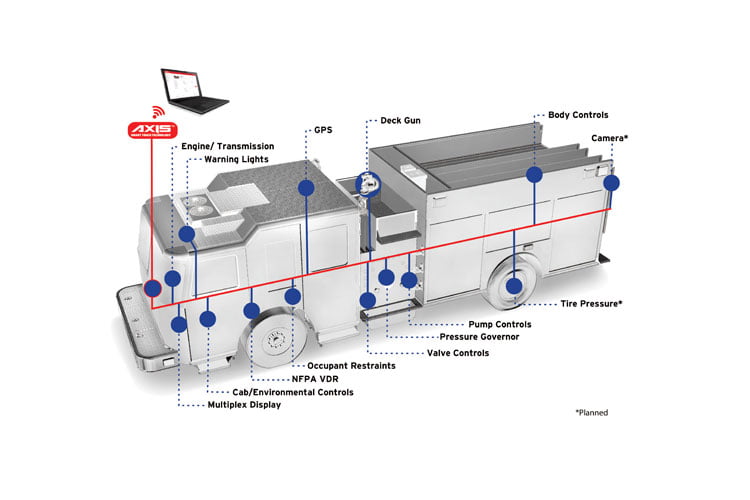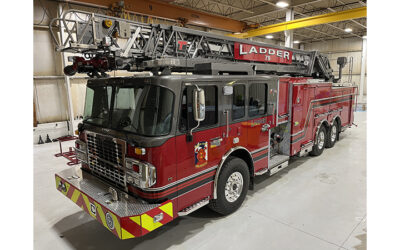Fire apparatus are getting smarter, easier to operate, and safer for firefighters thanks largely to electronic technology being incorporated into the veins of the trucks. AXIS™ Smart Truck Technology is one such system that connects to various components on an emergency vehicle and allows for streamlined operations, increased vehicle uptime, and improved health of the rig.
As a secure, intelligent truck system engineered specifically for E-ONE, KME, and Ferrara Fire Apparatus emergency response vehicles, AXIS Smart Truck Technology monitors the status of a vehicle’s chassis, its multiplexing systems, and water flow components. The system enables electronics troubleshooting and support through real-time notifications, run-log recording, remote diagnostics, and secure over-the-air device updates.
Using a computer, laptop or mobile device, a firefighter uses AXIS to examine various truck data and diagnostics, and to monitor up to five vehicle networks. The system also can be used to send remote updates to multiple components, as well as real-time vehicle notification via text or email to mobile devices. The main goal of AXIS is to provide maximum uptime for the vehicle, keeping it from going into out-of-service status. AXIS is set up so that it can send out notifications based on user-determined variables, e.g. fuel levels, ABS events, and so on.
AXIS communicates by a built-in modem through a small roof-mounted antenna connected through AT&T cellular service that’s provided for a five-year period.
In partnership with the REV Group, which owns E-ONE, KME and Ferrara Fire, HAAS Alert is being incorporated to work with AXIS Smart Truck Technology. HAAS Alert allows civilian vehicles to detect, in real time, when the emergency vehicle has its lights activated nearby and broadcasts the rig’s location to an app like WAZE.
HAAS Alert focuses on helping to alert drivers when emergency services vehicles are en route running emergency lights and sirens by sending an alert to the driver using a WAZE Smartphone navigation aid. The system will advise drivers when emergency equipment is on a scene, and whether an emergency vehicle is approaching from behind, the front, left or right.
Other technology making fire apparatus safer is a forward-looking radar on E-ONE apparatus that can detect developing rear-end collisions. Called OnGuard, the system was developed by brake system supplier Wabco. It has dual zones, one that takes a wide and close look in front of the vehicle and the other up to 600 feet ahead to detect any kind of developing rear-end collision. OnGuard looks at thousands of items ahead of it but tracks in great detail six vehicles as to their speed relative to the fire vehicle’s speed.
OnGuard bases its calculations on the driver’s steering position, the vehicle speed, whether or not brakes are being applied, and what the objects in front of the vehicle are doing. If OnGuard detects a potential impact, it watches if the fire apparatus driver is doing something about it, for example, steering to avoid. If he is and that path is not clear, OnGuard will intervene because it’s constantly watching all elements.
Should a collision be imminent, OnGuard first gives visual and audible warnings on a two- by five-inch multicolor display mounted in the driver’s view. Backlighting on the display would change from green to amber to red, depending on the situation. Green shows when OnGuard is tracking and displays the distance in feet to the vehicle that’s the priority object and its speed.
If that vehicle gets into a certain envelope, the background changes to amber. If the fire apparatus driver continues to approach at a high rate of speed and is not slowing down, OnGuard gives a haptic warning by popping the brakes so the driver feels a short brake pulse, and the screen turns red.
OnGuard is fully integrated with the vehicle’s brake system, engine throttle, engine retarder, and electronic stability control system, so if the driver still doesn’t take action, OnGuard starts limiting engine torque. If he continues to ignore the situation, it applies wheel brakes aggressively with 50 percent brake application. At that point, the driver would stand on the brakes himself to get 100 percent brake application and/or steer away from the situation. When OnGuard realizes the driver has hit the brakes or steered away, it releases its activity.
ALAN M. PETRILLO is a Tucson, Arizona-based journalist, the author of three novels and five nonfiction books, and a member of the Fire Apparatus & Emergency Equipment editorial advisory board. He served 22 years with the Verdoy (NY) Fire Department, including in the position of chief.






